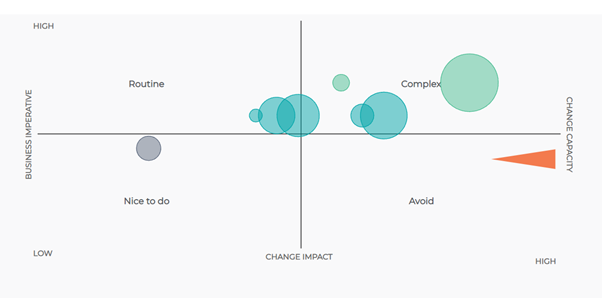Regulatory change, customer transformation, a restructure, some precursor technology changes to enable the customer transformation…and an office restack to prepare for our (second!) return to the office. Whew.
It sounds like a lot, but if you sit down with most Heads of Change or PMOs, it’s what you’ll hear.
It’s not unusual for organisations to have many firm-wide and department-specific initiatives in flight at the same time, and let’s not forget BAU—our actual reason for being: selling products or providing services and creating amazing customer experiences.
The research and consulting firm Gartner found that organisations have typically undertaken five major firmwide changes in the past three years, and 75% of those organisations expect to multiply that in the next three years.
So, things don’t appear to be letting up. But is that how things should be? Will leaders and their teams do their best work?
Let’s debate
Some say that since the unrelenting pace of change isn’t going to ease, the answer is to find ways to make it less disruptive—by building employee resilience.
We have a different point of view.
We think that in times like these—VUCA was coined long before the pandemic, but it aptly describes our world now—instead of seeking to make change less disruptive, organisations should be ruthless about priorities, saying “no” or “not right now” more than they say “yes” to new programs of work.
Saying no to most things will create the capacity to focus on the few initiatives that truly are priorities.
Apple’s Tim Cook said it brilliantly: they say no to very good ideas every day to focus on the few they do invest in—and execute them well.
4DX (Focus!)
We like research by Chris McChesney, Jim Huling and Sean Covey in the 4 Disciplines of Execution: Achieving your Wildly Important Goals.
The authors explain why it’s hard for organisations to execute and how leaders can prioritise their time so they can execute brilliantly—and achieve wildly important goals.
Of the four disciplines, or 4DX—focus, leverage, engagement and accountability—they say accountability is the most important, though nothing is possible without focus.
Focus is difficult for leaders because they’re continually drawn to new ideas.
But here’s the thing: remember the law of diminishing returns? The more you try to do, the less you accomplish.
Unfortunately smart, innovative leaders don’t want to do less, they want to do more. But there will always be more good ideas than we can execute, so leaders need to apply laser focus.
But doing less is easier said than done. What should be prioritised, and what deserves a “no” or “not right now”?
Here’s what we recommend.
Slow down to speed up
It starts with being ruthlessly clear about priorities.
This sounds simple and like it should be easy, but have you ever tried to get a group of executives to agree on what’s a priority and what isn’t?
Here are the steps to follow.
1. Know everything the organisation is working on!
Inventory every existing and proposed project (consider firmwide initiatives and department- or business unit-specific changes) and consolidate them into a master schedule. Include implementation timeframes, even if approximate, and which groups will be impacted—at all levels of the organisation.
This might take some time. It will require talking to each department or business unit to find out what’s in their pipeline, timeframes, if the initiatives are firmwide or something they’ve initiated, and if other departments or business units are impacted.
2. As you’re documenting the initiatives, categorise them
You could consider:
- Mandatory / regulatory / compliance
- Maintenance
- Enhancement
- Cost efficiency or reduction
- Growth
- Innovation
Or business importance:
- Elective effort (not strategic)
- Required improvement (not strategic)
- Strategic effort, low priority
- Critical business imperative
- Strategic business imperative
Then consider the change impact:
- No impact
- Minor impact
- Moderate impact
- High impact
- Very high impact
(Detailed readers, I can hear you: “but some initiatives are high impact in some areas but low impact in others, so what do we do?” Because this is the first pass that you’ll run by your most senior leaders, consider the aggregate impact.)
3. Gather the correct, appropriately senior stakeholders to prioritise the initiatives
Set the expectations with these leaders: to execute well, we need to be laser-focused, and there’s a wealth of research (in addition to our own personal experience) that shows diminishing returns when we take on too much.
Remind this group that it’s their role to manage the organisation’s capacity for change—to ensure there is available capacity to execute brilliantly. (It may help for someone at the EGM or C-level to send the invite and set the scene.)
With this group assembled, plot the initiatives on a chart with business importance on the Y-axis and change impact on the X-axis.
There will be some robust discussion and even some debate around where initiatives should fall. If things go off track, bring the group back to focus and remind them of the task: if we don’t create capacity in our teams, we won’t achieve our wildly important goals.
The output might look something like this:

Now you have a clear picture of what’s worth investing in and what should be avoided—or only tackled if time and resources permit.
4. Implement!
Now that you’ve cleared the path, the real work of implementation—executing brilliantly—begins.
Watch out for this ⚠
When faced with capacity challenges, sometimes leaders can be tempted to accelerate even more. (The thinking seems to be, “we’ve already started these, so let’s execute them faster so we can get to what’s really important.”)
Unfortunately, this doesn’t work. McKinsey & Co writes that speeding up isn’t the answer. It makes things more complex, takes more resources, and usually only solves part of the challenges.
Conclusion
We acknowledge this isn’t easy. But nothing about the last 18 months has been easy, and there are no signs the whirlwind is letting up.
We need to find a better way.
To quote McChesney and co: “Simply put, if you want to achieve goals you’ve never achieved before, you have to do things you’ve never done before. Changing human behaviour is never easy, but it’s even harder because of the second challenge: implementing these changes in an environment that’s already swirling with urgent priorities. Together, these challenges can derail even the best leaders from achieving their goals.”
All leaders have wildly important goals, but only those who focus on the right things will achieve them.
Look out for…ChangeViz!
Imagine a world where it’s easy to see your entire portfolio of changes and make wise, informed decisions about where to invest.
Building a heat map in Excel is better than nothing, but you want dynamic updates and to drill down or pan out in just a few clicks.
We build ChangeViz just for you, and it’s launching soon. Get on the list to hear when it’s ready.
Over to you! How do your leaders manage capacity for change across the organisation?
Contact us today
Looking to find out more about how we can transform your workplace. Get in touch with us today.
Enquire now


